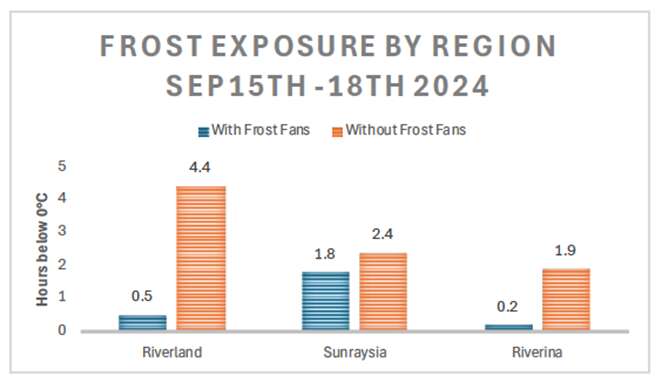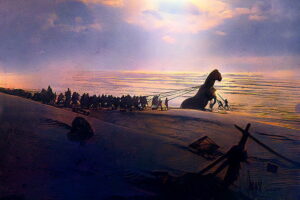
While frost protection measures have long been a staple in various agricultural sectors, the almond industry’s recent advancements in localized climate monitoring and smart fan-based protection are setting new standards for tree crop growers worldwide. These innovations demonstrate the potential of technology to safeguard crops against the increasingly unpredictable climate.
The 2024 Wake-Up Call
In September 2024, prolonged frost events swept across key horticultural regions in South Australia, Victoria, and New South Wales. From September 15–18, many growers faced consecutive nights of sub-zero temperatures, threatening their harvests. High-resolution data collected from FrostBoss frost fans, equipped with on-site temperature sensors, revealed the dramatic difference precise frost protection can make.
In the Riverland, an area known for both almonds and grapes, orchards without fans endured as many as 44 hours below 0°C during the four-day period. In stark contrast, orchards equipped with frost fans averaged just 12 minutes of exposure. This stark difference is not due to chance but is the result of accurately monitoring canopy-level temperatures and activating fans at the precise moment to draw down warmer air from the inversion layer, thus protecting vulnerable crops from damage.
Why Microclimates Matter
Like almond orchards, many tree crops are planted across undulating terrain, where cold air can pool in certain rows or blocks. These frost pockets can devastate part of a harvest while neighboring areas remain unscathed. Real-time, site-specific data confirms what many growers have suspected for years: frost risk can vary dramatically across short distances, making blanket weather station data insufficient.
The most effective protection comes from understanding an orchard’s microclimates and responding accordingly. This localized approach ensures that growers can make informed decisions to protect their crops effectively.
Smarter Fans, Better Decisions
Modern frost fans are not merely wind machines; they are intelligent tools. FrostBoss models, for example, continuously record canopy temperatures and trigger automatically when conditions demand. Data from 2024 showed that in protected almond blocks, sub-zero temperatures arrived up to 2.4 hours later than in unprotected areas. This extra window can mean the difference between preserving fruit and losing it entirely, whether the crop is oranges, cherries, or hazelnuts.
“Frost fans aren’t just insurance; they’re active tools for decision-making and long-term planning,” says climate scientist Dr. Stu Powell, manager of FrostConsult.
Data as the New Farm Asset
Dr. Stu Powell believes the future of frost management lies in pairing yield data with high-resolution climate data. “Once we can monitor harvest and yield at the same resolution as on-site temperature, precision orchard management becomes incredibly powerful,” he explains. For growers, this means smarter fan placement, more efficient operation, and the confidence to invest in permanent solutions tailored to their unique landscapes.
While each tree crop has its own biology and frost sensitivity, the core challenge remains the same: protecting vulnerable stages from sudden cold. The almond industry’s embrace of block-level monitoring and smart, responsive frost protection offers a proven model for other sectors to follow.
Planning for the Future
Frost events are no longer limited to traditional frost-prone regions and are appearing at unexpected times. This reality means orchardists can no longer consider frost as a rare event; it has become an operational reality. For growers across Australia’s tree crop industries, the goal is no longer just to recover from frost damage but to prevent it altogether.
By combining technology, data, and timely service, FrostBoss is helping orchard businesses protect today’s crop while safeguarding tomorrow’s income. As the next frost season approaches, growers must ask themselves not only if they have frost protection but if they have the right information to act at the right moment. In a changing climate, the difference between a full harvest and a frost-hit season can be just a few minutes—and the right technology can provide those crucial minutes.







